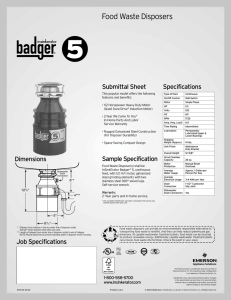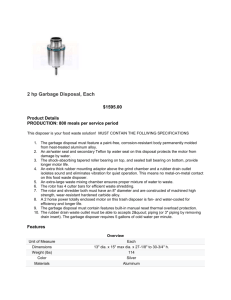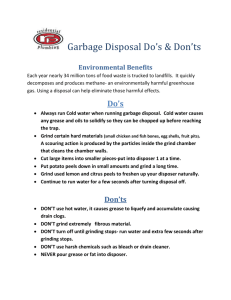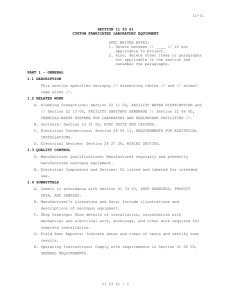Manual - Webstaurant Store
advertisement
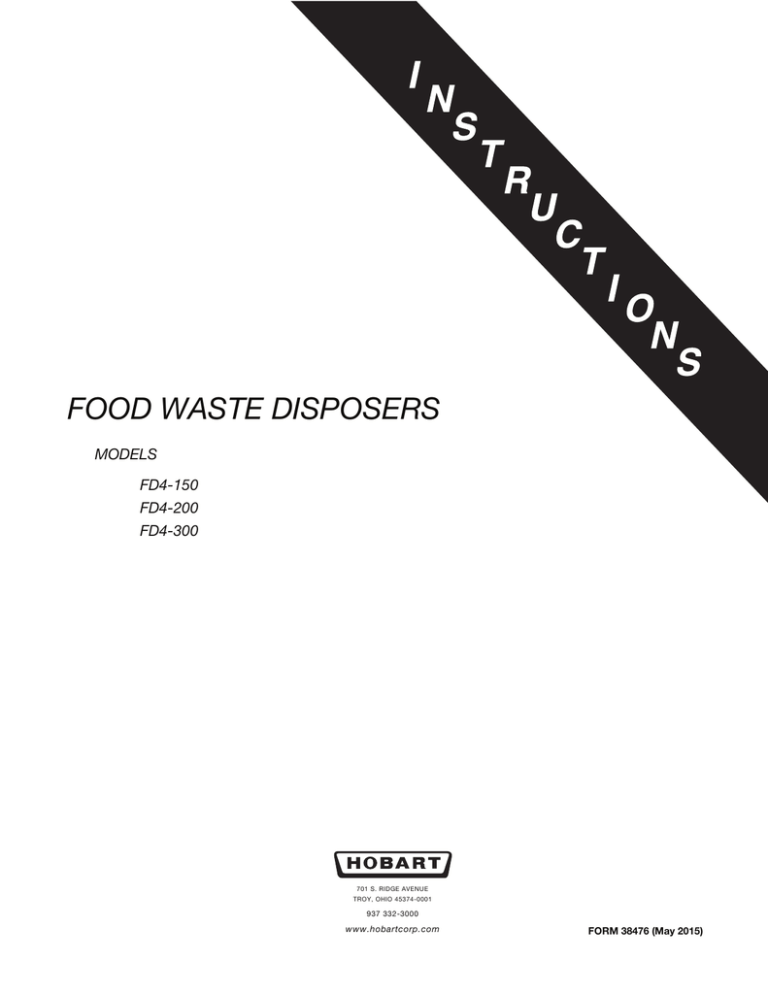
FOOD WASTE DISPOSERS MODELS FD4-150 FD4-200 FD4-300 701 S. RIDGE AVENUE TROY, OHIO 45374-0001 937 332-3000 www.hobartcorp.com FORM 38476 (May 2015) © HOBART CORPORATION, 2014 –2– TABLE OF CONTENTS SAFETY............................................................................................................................................. 4 INSTALLATION.................................................................................................................................. 5 Fabricating................................................................................................................................... 5 Plumbing Connections................................................................................................................. 5 Electrical Connections................................................................................................................. 6 Grounding.................................................................................................................................... 6 OPERATION....................................................................................................................................... 8 Cleaning....................................................................................................................................... 8 MAINTENANCE................................................................................................................................. 8 Lubrication................................................................................................................................... 8 Cutter Blocks............................................................................................................................... 8 Overload Protection..................................................................................................................... 8 –3– Installation, Operation and Care of MODELS FD4-150, FD4-200, & FD4-300 FOOD WASTE DISPOSERS SAVE THESE INSTRUCTIONS SAFETY RECOGNIZE SAFETY INFORMATION When you see this symbol on your machine or in this manual, be alert to the potential for personal injury. READ ALL INSTRUCTIONS Read this owner's manual before using the machine. Failure to follow the instructions provided could result in personal injury or equipment damage. KEEP OUT OF REACH OF CHILDREN This disposer is intended for commercial use only. THIS APPLIANCE IS NOT INTENDED FOR USE BY PERSONS (INCLUDING CHILDREN) WITH REDUCED PHYSICAL, SENSORY OR MENTAL CAPABILITIES, OR LACK OF EXPERIENCE AND KNOWLEDGE, UNLESS THEY HAVE BEEN GIVEN SUPERVISION OR INSTRUCTION CONCERNING USE OF THE APPLIANCE BY A PERSON RESPONSIBLE FOR THEIR SAFETY. DO NOT PUT HANDS OR ANY IMPLEMENT IN THE DISPOSER WHILE IN OPERATION. NEVER FEED WASTE BY HAND PAST VINYL SILVER TRAP SCRAPPING RING. DO NOT OPERATE IF DAMAGED. Do not install or operate this disposer if the disposer has been dropped or damaged in any manner. Contact the nearest factory-authorized service center for examination, repair, or adjustment. (Refer to the service list included in the Owner's Information Packet.) DO NOT LEAVE DISPOSER UNATTENDED WHILE OPERATING. SET THE POWER SWITCH TO OFF BEFORE CLEARING JAMS OR REMOVING OBJECTS FROM DISPOSER. When the disposer is wired to a Group 4 Control or Group 5 Control Panel, SHUT OFF the branch circuit main switch or disconnect. When the disposer is wired to a Group 6 Control Panel, TURN OFF emergency disconnect. Use long-handled tongs or pliers to remove objects. TO REDUCE THE RISK OF INJURY BY MATERIALS THAT MAY BE EXPELLED BY DISPOSER, DO NOT PUT THE FOLLOWING INTO DISPOSER: drain cleaner; glass, china, or plastic; large, whole bones; metal (bottle caps, tin cans, aluminum foil, etc); whole cornhusks. ALWAYS KEEP VINYL SILVER TRAP SCRAPPING RING OR SINK STOPPER IN PLACE, EVEN WHEN NOT IN USE. This reduces the risk of objects falling into the disposer. WHEN CLEANING KITCHEN AND DISPOSER AREA, ONLY DAMP WIPE OUTSIDE OF DISPOSER AND CONTROLS. DO NOT AT ANY TIME HOSE DOWN THE EXTERIOR SURFACES OF THE DISPOSER AND CONTROLS. –4– INSTALLATION Immediately after unpacking the disposer, check for possible shipping damage. If the disposer is found to be damaged, save the packaging material and contact the carrier within 15 days of delivery. Prior to installation, test the electrical service to make sure that it agrees with the specifications on the disposer data plate. Temporary support, such as blocking, must be provided for the disposer during installation to avoid excessive stress at welded or soldered cone to table connection. FABRICATING 1.Consult installation and connection data and installation diagrams on the following pages for cone or sink attachment dishtable cutout sizes. 2.For cone attachment, position cone so water swirl inlet fitting is nearest to operator. 3.Weld the total circumference of the cone or sink attachment to prevent leakage. 4.Smooth grind and polish to match and blend weld seams. Do not place control mounting brackets in direct water splash areas. PLUMBING CONNECTIONS codes. Plumbing connections must comply with applicable sanitary, safety, and plumbing 1. Consult installation and connection data and installation diagrams on the following pages for mounting, hookups, and pipe sizes. 2. Slide in, or position, disposer to connect to waste line, avoiding as many bends, elbows, and tees as possible. 3. Connect disposer from a 3⁄4" IPS cold water supply line. Install the flow control supplied with the disposer. If the water line pressure exceeds 60 psig, a pressure reducing valve (not supplied) should be installed. The minimum flow pressure for the disposer to function properly is 16 psig. Install a shutoff valve (not supplied) for proper servicing of the disposer. 4.All controls are supplied with a solenoid valve which must be installed in the water supply line as shown. 5.Install a vacuum breaker according to local plumbing codes. If local plumbing codes prohibit the use of vacuum breaker, install an air gap water inlet (not supplied) observing the local codes. 6.Secure disposer to floor using the holes provided in the feet. –5– ELECTRICAL CONNECTION Electrical and grounding connections must comply with the applicable portions of the National Electrical Code and/or other local electrical codes. Disconnect the electrical power to the machine and follow lockout/tagout procedures. This unit must be connected to a dedicated, acceptable motor control switch with a marked OFF position to disconnect the appliance from all ungrounded supply conductors. The switch must be mounted within sight of the disposer or sink opening for the disposer. Knockouts are provided in the motor junction box for making electrical connections to the unit. Flexible conduit should be used to permit moving the unit for periodic servicing and maintenance. Select and follow wiring diagram, furnished with machine, applicable to your disposer and electrical service. Do not place control in direct water splash areas. Follow supplied wiring schematics for all controls, solenoid valves and pre-wired custom control centers. Size and fuse disposer branch circuit or use circuit breakers as required by motor nameplate rating. Check that motor voltage wiring matches incoming voltage. All conduit and fittings shall be of the NEMA 4 watertight type. Disposers have thermal protection of the manual reset type in motor. Check that reset button is not jammed. Check that all connections are tight, secure, and well grounded. Disposers are designed to operate in both a clockwise and counter-clockwise direction. Direction of rotation does not have to be considered when wiring motor. GROUNDING Connect disposer to a grounded metal permanent wiring system or run a disposer grounding conductor with the circuit conductors and connect it to the disposer grounding terminal or lead on the disposer. –6– 15" 6 1/2" 6 1/2" 34" 2" 2" DRAIN LINE *27 3/8" 0"-6" FOOT ADJUSTMENT 6 1/4" 8" * HEIGHT CAN VARY FROM 22-5/8" TO 28-7/8" –7– OPERATION Before operating disposer make sure it is clear of foreign objects such as metal or wire clippings, screws, nails, etc., which may have dropped into it during installation. Check the flywheel for free rotation. Never use your hand to check rotation of flywheel or to remove foreign matter from the disposer. Use a stick or similar object to turn the flywheel. Foreign matter can be removed with tongs or pliers. Start the disposer before feeding food waste. Be sure water is flowing. With typical optional controls, water flow and unit starting are simultaneous and automatic. Feed food waste into disposer. DO NOT feed china, metal, rags, clam shells, or similar material into the unit. DO NOT put grease or oil in the disposer. Oil or grease can clog the drain. Always allow the disposer to run for a short period after grinding is complete to assure proper flushing of the disposer and waste line. This flushing is automatically controlled with certain optional controls. CLEANING The food waste disposer should be kept in a clean and sanitary condition. Allow the disposer to run a few minutes after disposing of all food waste to completely flush out the interior. If food waste is allowed to accumulate due to improper clean-up, it will give off offensive odors. If this happens, cleaning can be accomplished by using a stiff brush with a strong soap and hot water solution. Light cleaning can be accomplished by grinding ice and a lemon through the disposer. disposer. Do not use chemical solvents or other drain cleaning compounds through the MAINTENANCE LUBRICATION No lubrication is required for the food waste disposer. The disposer has grease packed sealed bearings requiring no service. CUTTER BLOCKS The cutter blocks (1, Fig. 1) may be rotated by a qualified Hobart Service Technician if the cutting edges become worn. OVERLOAD PROTECTION The disposer motor is protected by a thermal, resetable overload protector and will trip if the motor is overloaded. To reset, allow approximately five minutes for cooling, then press the manual reset button located on the motor shell opposite the motor junction box. An arrow on the motor shell indicates location of the button. Restart the disposer using normal operating procedure. If overload protector continues to trip, contact your local Hobart Service Office. FORM 38476 (May 2015) –8– PRINTED in U.S.A.
